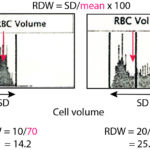
The red blood cell distribution width (RDW) is an index of the variation in cell volume within the red blood cell population. It is a result provided by automated hematology analyzers and is the electronic equivalent of anisocytosis or variation in red blood cell size that is judged by smear examination. Mathematically, it is the coefficient of variation, i.e.,
RDW (%) = (Standard deviation ÷ mean) cell volume x 100
A high RDW indicates that the red blood cells are more variable in volume than normal. This may be due to the presence of smaller or larger red blood cells or a combination of either scenario. For example, increased numbers of immature red blood cells during a regenerative response to an anemia will increase the RDW, because immature anucleated red blood cells are typically larger than normal. Conversely, the presence of increased numbers of smaller cells (e.g. in iron deficiency anemia) will also increase the RDW. The cause for a high RDW may be revealed by examination of a blood smear to identify the presence of small or large red blood cells. Note that low numbers of smaller or larger red blood cells may increase the RDW before an increase or decrease in mean cell volume (MCV) can be seen on the hemogram. An RDW within reference intervals provides little information on variation in red blood cell size. An RDW below the reference interval is not a clinically relevant finding.
